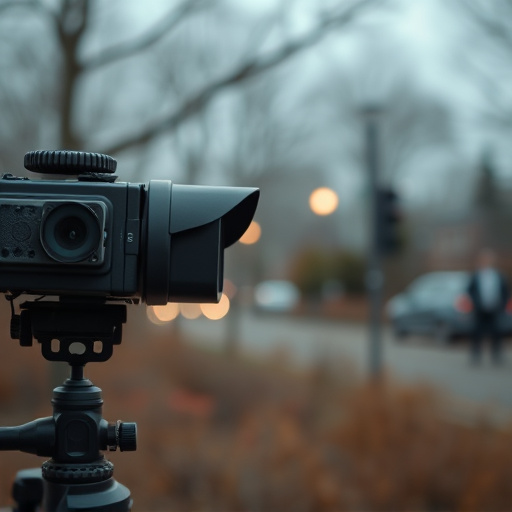Hidden cameras with night vision recording capabilities, employing infrared technology to capture images in darkness, pose significant privacy risks. These devices range from everyday object mimics to integrated models in items like light switches or fire alarms. Detection requires understanding their operation: converting ambient light into usable imagery and using IR LEDs when light levels drop. Tools such as RF detectors and frequency scanners are critical for identifying wireless transmissions. Keen observation of visual clues, anomalies in security, and behavior can also indicate their presence. Prioritize safety, use specialized equipment, and be aware of legal regulations regarding surveillance and consent to mitigate potential privacy breaches.
Uncover the insidious world of hidden cameras with our comprehensive guide. Learn how to detect surveillance devices equipped with night vision recording capabilities. We’ll explore effective methods for identifying radio frequency (RF) signals, visual clues, and anomalies that reveal their presence.
From specialized tools and techniques to essential safety precautions and legal considerations, this guide equips you with the knowledge needed to navigate this intricate landscape. Stay informed and protect your privacy in today’s digital age.
- Understanding Hidden Cameras with Night Vision
- Detecting RF Signals: Tools and Techniques
- Identifying Visual Clues and Anomalies
- Safety Precautions and Legal Considerations
Understanding Hidden Cameras with Night Vision
Hidden cameras equipped with night vision recording capabilities have become increasingly sophisticated, making them harder to detect. These devices utilize infrared (IR) technology to capture images and videos in complete darkness, offering a level of discretion that poses significant privacy risks. Night vision hidden cameras can be found in various forms, from tiny pins that mimic everyday objects to more advanced models embedded in items like light switches or fire alarms.
Understanding how they work is crucial for detection. These cameras convert ambient light into usable imagery through image intensification or thermal imaging. When light is scarce, they activate IR LEDs that emit light outside the visible spectrum, allowing the camera’s sensor to capture details that would otherwise be unseen. This technology has led to the proliferation of covert surveillance equipment, highlighting the need for consumers and professionals alike to remain vigilant and invest in counter-surveillance measures to protect their privacy.
Detecting RF Signals: Tools and Techniques
Detecting RF signals is a crucial step in identifying hidden cameras, especially those equipped with night vision recording capabilities. Tools like RF detectors and frequency scanners are essential for this task. These devices can pick up on wireless transmissions from covert surveillance equipment, allowing users to pinpoint the source of the signal. By scanning through various frequencies, professionals can uncover hidden cameras that may be broadcasting at specific ranges or using particular protocols.
Advanced techniques involve analyzing patterns in RF signals and comparing them to known signatures of common hidden camera systems. This method requires expertise and specialized software to interpret the data accurately. With the right tools and knowledge, detecting these miniature, often invisible devices becomes a more feasible task, ensuring privacy and security in various settings, from homes to public spaces.
Identifying Visual Clues and Anomalies
In the quest to detect hidden cameras, especially those equipped with night vision recording capabilities, keen observation is key. Visual clues can often give away the presence of such devices. For instance, look for any unusual lighting or shadows in an otherwise dark area. A faint glow from a tiny lens or irregular reflections on surfaces could indicate a hidden camera. Even subtle distortions on images or videos, like distorted edges or unnatural blurring, might suggest the presence of a camera with advanced sensors.
Anomalies in environments are another telltale sign. A sudden increase in security personnel or unusual behavior by individuals can be indicative of surveillance activities. Additionally, the presence of strange objects or devices, such as small boxes or lenses attached to walls or ceilings, should raise suspicions. By being vigilant and examining surroundings for these visual cues, one can effectively navigate and mitigate potential privacy breaches involving hidden cameras with night vision recording capabilities.
Safety Precautions and Legal Considerations
When detecting hidden cameras, especially those equipped with night vision recording capabilities, it’s paramount to prioritize safety precautions. This involves ensuring that your methods do not pose any harm or risk to individuals or property. Always conduct searches responsibly and respectfully, respecting privacy rights and legal boundaries. Using specialized equipment designed for such tasks can help mitigate potential risks, as it allows for detection without physical intrusion.
Legally, the use of hidden camera detection tools is subject to varying regulations depending on your location. In many jurisdictions, there are strict rules regarding surveillance, consent, and the legal basis for recording. It’s crucial to familiarize yourself with these laws to avoid any unintended legal repercussions. Remember that even legitimate concerns about hidden cameras should be addressed through appropriate channels, such as reporting to relevant authorities or seeking professional assistance from cybersecurity experts.
In today’s digital era, understanding how to detect hidden cameras with night vision recording capabilities is an essential skill for maintaining privacy. By familiarizing ourselves with RF signal detection, visual clue identification, and legal considerations, we can navigate our surroundings with greater awareness. Remember that staying proactive in safeguarding personal and sensitive information is crucial, and these techniques empower individuals to protect their privacy effectively.
